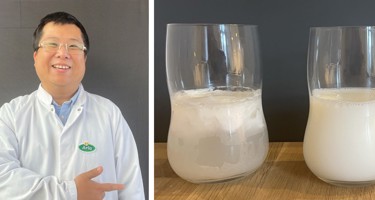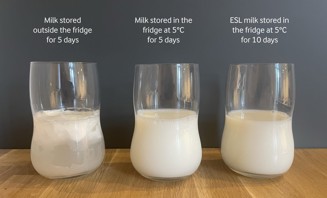
How long does milk last? Is it possible to extend the shelf-life of milk without compromising on food safety and freshness? We’ve teamed up with our Senior Scientist Yinghua Xiao to find out. He specialises in microbiology, food safety and dairy shelf-life.
You’re standing in front of the refrigerator, nose deep in a carton of milk, praying it isn’t as old as you think it is and hoping you aren’t met with the scent of spoilage.
Haven’t we all been there? Forced to drink our morning coffee without milk, or left the cereal dry in the bowl. The truth is… milk doesn’t last forever.
Besides offering important nutrients, milk is also a living product – like all fresh foods are - that contains microbes and bacteria which will make it perish over time. However, how long that process takes depends on how the milk is handled from farm to fridge.
What is fresh milk?
First of all, it’s worth noting that there is no official definition of what “fresh milk” is. “Fresh milk” refers to many different types of milk and there is no one fresh milk process as such. Fresh milk comes in many varieties including full-fat milk, skimmed milk, lactose-free milk and the list goes on.
The definition of freshness ultimately comes down to what consumers perceive as “fresh”.
For a lot of Scandinavians, “fresh milk” is milk delivered and consumed 24-72 hours after being milked at the farm whereas consumers in Germany, the UK or the Middle East perceive milk as fresh for more than a week.
What all of these different types of milk have in common though, is that they are all pasteurised.
This means that the milk has been heated for at least 15 seconds at 72 degrees and rapidly cooled back down to make sure there is no harmful bacteria in the milk and it’s safe to consume. Pasteurised milk has a shelf-life of 5-10 days unopened (In European markets up to 14 days).
But actually… the process of producing safe and fresh milk starts already at the farm. High quality raw milk is essential to ensure a milk with a shelf-life of 5-10 days.
In Arla, we have a unique quality programme called Arlagården®, which sets high standards for how our milk should be produced. All of our farmer owners have committed to these.
How milk is kept cold from farm to fridge
After milking at the farm, the shelf-life relies on the milk being handled carefully and stored at the right temperatures from farm to fridge. This journey is also called “the cold chain”.
Scientist and food microbiologist, Yinghua Xiao explains how “the cold chain” works in this video:
One reoccurring item in the video above is the number “5”.
5 degrees Celsius.
If the milk is not kept at this temperature there is a bigger risk that the bacterial spores (the microbes that can survive pasteurisation but are inactive) – can grow and make the milk perish sooner. The recommendation for consumers is therefore always to store the milk in the fridge at 5 degrees Celsius as it is best preserved at this temperature.
In European markets, where the cold chain is well-established it is possible to produce a pasteurised milk with a shelf-life between 7-14 days.
What milk looks like if the cold chain is broken
Can you spot the difference between the two glasses of milk in the pictures below?
On the left-hand side, you see a glass of fresh milk which has been stored outside the fridge for five days. On the right-hand side, you see a glass of milk from the same carton, which has been stored in the fridge at 5 degrees Celsius for five days.

In other words, storing fresh milk at the right temperature is crucial to ensure its shelf-life, as it is with all fresh foods.
How we can extend the shelf-life of milk up to 28 days
In Arla, our top-priority is to deliver fresh and high-quality milk that is safe to consume, but we are also interested in extending the life of our products when possible to avoid good products going down the sink and to make it possible for consumers to enjoy the product for longer.
Therefore, we also produce a milk type called Extended Shelf-Life milk, also known as ESL milk among dairy experts. This milk can last up to 28 days if it’s unopened – fresh and safe to consume.
How is that possible?
To extend the shelf-life of fresh milk we need to reduce the number of microbes and bacterial spores even further after it has been pasteurised. The fewer spores present in the milk, the longer the shelf-life.
In Arla, we use two different technologies for this; microfiltration or bactofugation. Bactofugation is done by using a centrifuge, where high-speed rotation separates the bacteria from the rest of the milk. With microfiltration, we run the milk through a special membrane - or filter if you like - to separate the bacterial spores from the milk.
Microfiltration is the technology most often used in Arla, Yinghua Xiao explains how it works in this video:
Since these methods do not require extra heat treatment to reduce the amount of bacterial spores, we can to a large extent preserve the flavour as well as the nutritional profile of the milk. And voilá! You have a safe milk that lasts for longer.
In the pictures below, you see from the left a glass of fresh milk that has been stored outside the fridge for five days, a glass of fresh milk that has been stored at 5 degrees Celsius for five days and finally a glass of Extended shelf-life milk that has been stored at 5 degrees Celsius for 10 days – still fresh and safe to consume.

What is the difference between ESL milk and UHT milk? ESL milk retains a fresher taste and nutritional profile compared to UHT milk. The majority of the ESL milk we produce in Arla does not go through extra heat treatment after pasteurisation. This means we can preserve a large part of the natural flavours and nutrients of the milk.
Due to the higher temperature used in processing, UHT milk may have a slightly different taste and aroma compared to fresh milk or ESL milk. Some people describe UHT milk as having a slightly "cooked" or "caramelized" flavour. The high heat treatment also affects the nutritional profile to some extent, causing changes in certain vitamins and enzymes depending on the temperature applied. UHT milk does not require cooling and has a shelf-life between three-six months.
Why not only produce ESL milk instead of pasteurised milk – to extend shelf-life overall? In Arla, we produce both pasteurised milk, ESL milk and UHT milk to consumers. There are different reasons why. Firstly, many consumers prefer the taste and characteristics of pasteurised milk over ESL milk even though there is only a slight difference. Secondly, it is more expensive to produce ESL milk because of the technological setup in production.
About Yinghua Xiao

Xiao is a passionate microbiologist originally from China. He moved to the Netherlands to study his Master’s degree in food safety and later his Ph.D. in food microbiology specializing in bacterial spores, at Wageningen University and NIZO food research. Xiao is a father and together with his family, he moved to Denmark to pursue a career in Arla. Today he has become a senior scientist in Arla’s Innovation Centre, primarily focusing on food safety and shelf life.